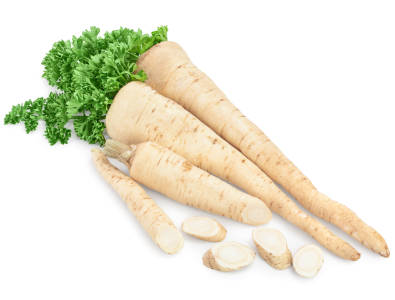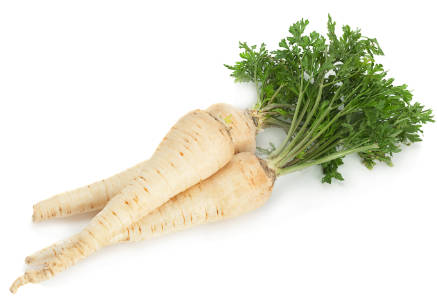All Ingredients
parsley root
This is hard to find in the United States, but it's a popular root vegetable in Central Europe. For more information, see the Wegman's Food Market's page on Parsley Root.
Learn moreparsnip
These are like carrots, except that they're cream-colored and never served raw. Northern Europeans like to add them to stews, but they can also be puréed or served as a side dish. Choose small, crisp ones.
Learn morepartridge
These small, plump birds are related to pheasants, and very tasty. Varieties include the chukar, red-legged partridge = French partridge, and grey partridge = English partridge.
Learn morepasilla chili
This is the dried version of the chilaca chili. It's mild, long, black, and wrinkled, and a standard ingredient in mole sauces. Ancho chilies are sometimes mislabeled as pasillas.
Learn morepassion fruit
This nutritious, aromatic fruit has a tart, sweet flavor. The sweet purple variety is the most common, but you can also find yellow passion fruit (sometimes called golden passion fruit), which is more acidic, and a giant version that has a more subtle flavor. Choose fruit that have wrinkled skins (indicating that they're ripe) and heavy for their size. To eat one, cut it in half and scoop out the pulp. You can eat the small seeds, but some people remove them.
Learn morepasta
This page shows substitutions for pasta in general. For information about how to select, cook, and store pasta, along a list of different varieties, click here.
Learn morepasta al ceppo
This means "pasta on a stick" in Italian, and this tubular pasta was originally made by wrapping dough around knitting needles.
Learn morepasta filata
These cheeses are stretched and pulled like taffy before being molded, which gives them a springy, elastic consistency. It is made from cow or buffalo milk. Unlike many cheeses, they stand up well to cooking. This category includes mozzarella, Provolone, Scamorza, string cheese, and Caciocavallo.
Learn morePasta Ribbons
Ribbons of pasta are usually available either fresh or dried. Use fresh ribbon pasta for light, delicate sauces and dried for the rich, heavier ones.
Learn morePasta Rods
Long strands of pasta are challenging to eat, and that's part of their charm. Medium-sized rods like spaghetti are normally served with light tomato-based sauces. Thin rods like angel hair pasta and vermicelli work best in broths or with thin sauces, while thicker rods like perciatelli go well with heavier, chunkier sauces. Rods are best if they're served immediately after being cooked. If you're planning to serve a lot of people, consider using small pasta tubes or shapes.
Learn morepasta sheet
Use this sheet of fresh pasta in place of lasagna, or to make your own stuffed pasta. You can sometimes buy it where fresh pasta is made in-house.
Learn morePasta Tubes
With their thick walls, tubular pasta like penne and macaroni are ideal for pasta salads, thick sauces, and casseroles. Long tubes like perciatelli are often served with sauces, or they're broken up and used in soups. Large, wide tubes like cannelloni and manicotti are stuffed and baked. Tubes with grooves on the exterior, denoted by the Italian adjective "rigati" or "rigate" after the pasta's name, do a better job of holding sauces. Smooth-walled pasta is called "lisci" or "lisce."
Learn morepasteurized process cheese
Look for this in deli counters and in holiday gift packs. This cheese is a blend of fresh and aged cheeses, and it's pasteurized to stop the ripening process. This improves shelf life but impairs flavor. Nuts, fruits, and other seasoning are often added.
Learn morepasteurized process cheese food
This cheese is similar to pasteurized process cheese, but it contains more milk solids and water. Velveeta is a popular brand.
Learn morepasteurized process cheese spread
This cheese is similar to pasteurized process cheese, but it's moister. Cheez Whiz is a popular brand.
Learn morepastis
This is a licorice-flavored liqueur that the French like to serve with water. It's higher in alcohol than anis or anisette. Popular brands include Pernod and Ricard.
Learn morepastrami
This is beef brisket that's been seasoned and dry-cured. It's often served hot on rye bread.
Learn morepâté
Leave it to the French to come up with this buttery rich delicacy. Goose pâté is pricier and more subtle than duck pâté, and is the best choice if you plan to serve the pâté cold. Duck pâté works best in warm dishes. Some people refuse to eat pâté de foie gras from France because the animals are force-fed to enlarge their livers.
Learn morepatty shell
These are small cups made of puff pastry that are meant to hold individual portions of savory fillings. Look for them in bakeries or among the frozen foods in supermarkets.
Learn morepattypan squash
These have a pleasant, nutty flavor. They're small enough to grill whole, but lots of recipes call for them to be hollowed out, stuffed, and baked. There are green and yellow varieties; yellow ones are sometimes called sunburst squash.
Learn morepawpaw
Real pawpaws are native to North America, and have green peels, orange flesh, and taste like a blend of tropical fruit. They're hard to find in markets, though, since they must be eaten within a few days of being picked. Pawpaws continue to ripen after they're picked, and should be eaten only when they yield to a gentle squeeze, like a ripe avocado. Australians use the name pawpaw for the papaya, while others use it for the cherimoya.
Learn morepea eggplants
These tiny Thai eggplants are quite bitter. They're sold in clusters and look like large green peas. You can find them fresh in Thai markets, or buy them pickled in jars.
Learn morepeach
Most of the peaches that are sold in markets are freestone, and de-fuzzed by the grower. Select peaches that are colorful and free of bruises. After you get them home, let them ripen at room temperature for a day or so until they become softer. They're best and cheapest in the summer.
Learn morepeanut
These aren't really nuts, but legumes that grow underground. They're cheaper than most nuts, and are often eaten out of hand or incorporated into candies, stir-fries, or trail mixes. You can buy them shelled or unshelled, salted or unsalted, raw or roasted. To roast, place shelled peanuts on a cookie sheet in a 350° oven for about 15 to 20 minutes. Since many people are allergic to peanuts, it's important to alert guests if you're serving something that's made with peanuts or peanut products.
Learn morepeanut butter
High in protein and low in cost, peanut butter is a sandwich staple. It's often teamed with jelly, but honey, bananas, onions, and even pickles work well too. Natural peanut butter is made simply of peanuts, oil, and sometimes salt. It's not very popular with consumers, though, since it needs to be refrigerated after opening, and the oil tends to separate and rise to the top. Most shoppers turn instead to commercial peanut butters, which don't need to be refrigerated and don't separate. Unfortunately, these products are made with hydrogenated oils, which are bad for you. Since many people are allergic to peanuts, it's important to alert guests if you're serving something that's made with peanut butter.
Learn morepear
It's hard to improve on the flavor of a soft, juicy raw pear, but combine it with blue cheese or prosciutto, and you'll have something truly divine. You can also bake or poach pears, or use them to make tarts. They become soft and fragile when they're ripe, so grocers want you to buy them while they're still hard and then ripen them at home for a few days. Putting them in a paper bag speeds up the process. They're ready to eat when the base yields slightly to pressure from your thumb. For information about different varieties of pears, click here.
Learn morepear brandy
Brandy made from Williams pears (like Poire Williams and Williamine) are especially good. Some bottles have an entire pear in the bottle.
Learn morepearl barley
This is the most common form of barley, but not the most nutritious. While hulled barley loses only the thick outer hull in the milling process, pearl barley is stripped of the nutritious bran layer as well, leaving just the "pearl" inside. Despite this, it's still fairly nutritious. It takes about an hour to cook.
Learn more


































































































































































































































































































































































